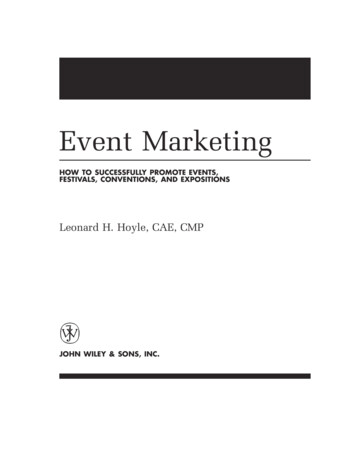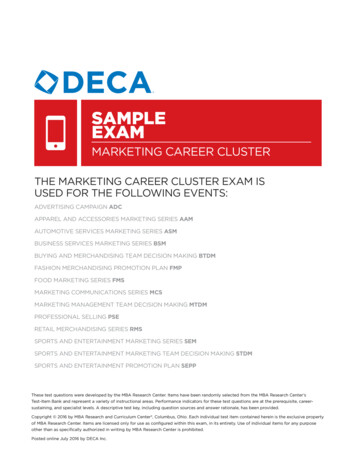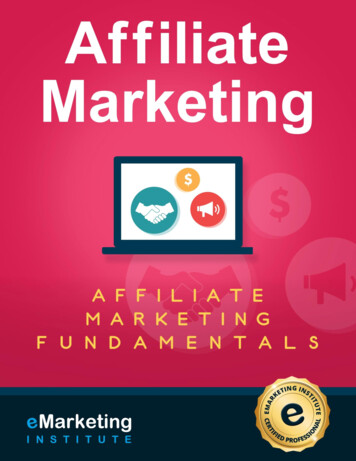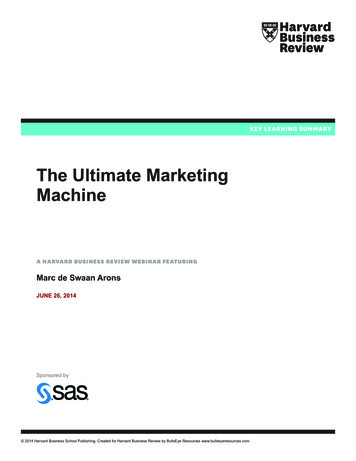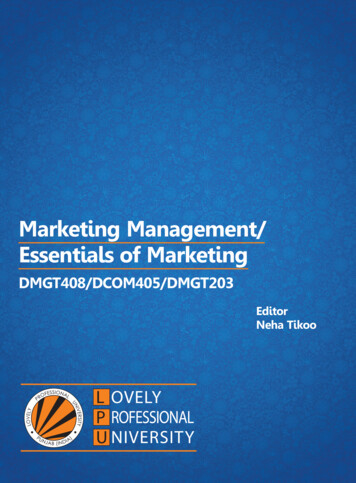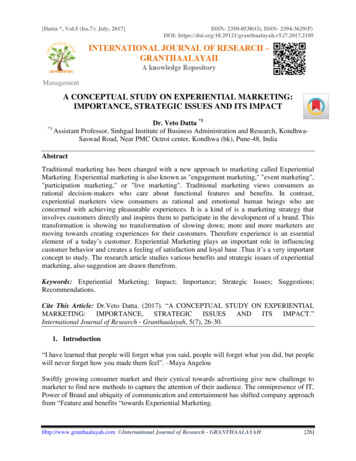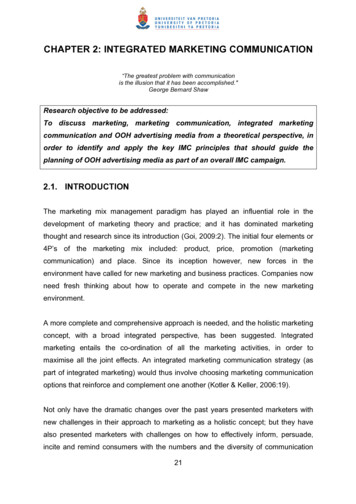
Transcription
CHAPTER 2: INTEGRATED MARKETING COMMUNICATION“The greatest problem with communicationis the illusion that it has been accomplished."George Bernard ShawResearch objective to be addressed:To discuss marketing, marketing communication, integrated marketingcommunication and OOH advertising media from a theoretical perspective, inorder to identify and apply the key IMC principles that should guide theplanning of OOH advertising media as part of an overall IMC campaign.2.1. INTRODUCTIONThe marketing mix management paradigm has played an influential role in thedevelopment of marketing theory and practice; and it has dominated marketingthought and research since its introduction (Goi, 2009:2). The initial four elements or4P’s of the marketing mix included: product, price, promotion (marketingcommunication) and place. Since its inception however, new forces in theenvironment have called for new marketing and business practices. Companies nowneed fresh thinking about how to operate and compete in the new marketingenvironment.A more complete and comprehensive approach is needed, and the holistic marketingconcept, with a broad integrated perspective, has been suggested. Integratedmarketing entails the co-ordination of all the marketing activities, in order tomaximise all the joint effects. An integrated marketing communication strategy (aspart of integrated marketing) would thus involve choosing marketing communicationoptions that reinforce and complement one another (Kotler & Keller, 2006:19).Not only have the dramatic changes over the past years presented marketers withnew challenges in their approach to marketing as a holistic concept; but they havealso presented marketers with challenges on how to effectively inform, persuade,incite and remind consumers with the numbers and the diversity of communication21
options available. During recent years, the marketing communication environmenthas experienced the fragmentation of traditional advertising media, as well as theemergence of new non-traditional media. As a result, modern marketing has had toemploy a host of different communication options, in order to get the message to thetarget market. Researchers have traditionally studied the effectiveness of thesedifferent communication options or media types in isolation. This approach has,however, failed to recognise that potential interactions and synergy may existbetween the various options that make up a communication programme.These differences might have had an effect on the consumer’s response. As a resultof this oversight, it has been suggested that researchers should study the marketbetter; and marketers should employ integrated marketing communication (IMC)methods, in order to support their brands (Keller, 2001:819). The emergence of IMChas been regarded as the most significant example of development in the marketingdiscipline; and since the 1990’s, it has become a really hot topic in the field ofmarketing (Holm, 2006:23).The changing media landscape also requires a rethinking of media planning; andmedia synergy is considered to be a key element in moving forward. The challengefor future marketers will be to have an understanding of all the interactions amongand between all media forms, when processed by the consumer. The new approachto media planning should start with the consumer, where horizontal, not verticalmedia planning, is conducted – based on an understanding of how media formsinteract with each other when consumed by the audience (Schultz, 2006:25).Given the current focus on the study of the integration and planning of OOHadvertising media (as one of the elements in an IMC mix) in South Africa, the basicfeatures and principles of marketing, marketing communication, as well as IMC,need to be explored further, in order to gain an understanding of OOH advertisingmedia in the context of the larger discipline.22
2.2. MARKETINGMarketing is recognised by organisations as an important business function thatplays a critical role in their effort to gain a competitive advantage in the market place.A number of interconnected basic features of contemporary marketing, namely:customer-centric, communication and long-term relationship focus on customers, aswell as the inclusion of all relevant stakeholders, as often reflected in currentparadigms of marketing theory will be discussed in order to contextualise the currentstudy within the larger discipline.The traditional definition of marketing was released by the American MarketingAssociation in 1985 and states that “marketing is the process of planning andexecuting the conception, pricing, promotion and distribution of ideas, goods andservices to create exchanges that satisfy individual and organisational objectives”(AMA, 2007). This definition focuses on exchange as central concept. It suggeststhat the parties involved must have something of value to offer to the other party andmust have the desire and ability to give it up and find a way to communicate with oneanother.However the marketing discipline has changed and no longer focuses on short-termexchange or is not limited to consumers only. Contemporary consumers are far moreempowered due to their ability to control information technology, access information,purchase products and services anywhere, anytime. Consumers decide whatconstitutes value and what relationships are important, needed and wanted and notmarketers (Luck & Moffatt, 2009:314).The traditional definition above ignored these marketing ideas and the centralpremise dominated by the customer, stakeholders, and global and interactivemarkets. Consequently, in 2004 the definition was revised to reflect these changesto: “marketing is the activity, set of institutions and processes for creating,communicating, delivering and exchanging offerings that have value for customers,clients, partners, and society at large” (AMA, 2007). Creating, communicating, anddelivering value is thus the current focus. Marketing is regarded as an integrated23
process through which companies create value for customers and build strongcustomer relationships in order to capture value for customers in return. Marketdriven companies thus place the emphasis now on developing and sustainingrelationships with their customers as well as other stakeholders.Bearden, Ingram and La Forge (2007:6) affirm this relationship perspective tomarketing by replacing the emphasis on short-term sales to focusing on thedevelopment, maintenance and growth of long-term and beneficial relationships withtargeted customers. Relationship marketing orientation is a refinement of themarketing concept. Its implementation can foster customer loyalty and customerreferrals – resulting thereby in increased sales, market share and profits (Lamb etel., 2003:10). Kotler and Keller (2006:60) explain the main goal of marketing is todevelop deep, enduring relationships with people and organisations that coulddirectly or indirectly affect the success of the firm’s marketing activities. Thus,relationship marketing aims to build mutually satisfying long-term relationships withkey constituents in order to earn and retain their business.Duncan (2005:57) also emphasises the importance of building long-termrelationships with customers and other relevant stakeholders. He notes that theprimary relationship focus of a company is on its customers and internal employees;but a beneficial long term relationship with several other stakeholders – includingsuppliers, shareholders (from the financial and investment community), the broadercommunity, government regulators, media and agencies (for those companies thatuse their services) and distribution-channel members is also important.Lamb, Hair, McDaniel, Boshoff and Terblanche (2003:5) explain that marketing is aphilosophy or perspective based on customer satisfaction, and a set of activitiesneeded to implement this philosophy. Marketing is therefore more than a just set ofprocedures; it is rather a philosophy with customer satisfaction as the foundation orunderlying principle driving the whole process. It is clear that the marketingexchange process should lead to customer satisfaction, which underpins thecontemporary marketing philosophy. This consumer or marketing orientation is alsoreferred to as the marketing concept or orientation. Having satisfied customers24
indicates that the marketing concept has been implemented successfully; therefore,this should be the main thrust of marketing.Vargo and Lusch (2004:6) note that this customer-centric philosophy entails morethan simply being consumer oriented; it means collaborating with and learning fromcustomers and being adaptable to their individual and dynamic needs. It also meansthat value is defined by and co-created with the consumer, rather than beingincorporated somehow in output. Customer experience is a logical extension of thiscustomer centricity in the modern age of marketing. The focus on customerexperience is a recent paradigm shift in marketing; and this accentuates the centralrole of the customers in the total experience. This is created from a set ofinteractions between a customer and a product, a company, or part of itsorganisation, which results in a reaction. This experience is highly personal; and itimplies the customer’s involvement at different levels – ranging from the cognitive,the emotional, the sensorial, the physical or tangible, to even the spiritual dimension(Gentile, Spiller & Noci, 2007:397).The development of an overall marketing offer or marketing mix to satisfy the needsof selected profitable target market(s) or consumers forms the basis of marketingstrategies. Decisions concerning the central marketing mix elements, specifically:product, price, marketing communication, distribution and providing people physicalevidence and processes when dealing with services, are effectively combined into aconsistent and effective marketing programme for a specific market (Bearden et al.,2007:13). In this regard Duncan (2005:14) suggests that companies should becustomer-centred and focus externally on the needs and wants of their customers(referred to as external or customer orientation), as opposed to focusing internally onthe product, price, promotion and place (internal orientation).Consumer or marketing-oriented companies concentrate on satisfying the needs andpreferences of customers – by selecting one or more specific customer group(s) inthe total market, and then developing a market offering for each target group.Marketing-oriented companies achieve their business goals by focusing on theneeds and wants of their target market(s) (Lane et al., 2011:126).25
Furthermore, they should also deliver the desired customer satisfaction moreeffectively and efficiently than do their competitors (Kotler & Armstrong, 2001:137).Creating and maintaining a competitive edge is a critical part of the marketingprocess. This competitive advantage can be achieved in several ways. One way isby presenting the market with a superior or different offering; while creatingcommunication that results in a strong relationship between the company and thecustomer is another (Duncan, 2005:14).To deliver value and build long-term brand relationships, careful planning andintegration of the marketing mix elements into a unified market offering to satisfy theneeds of the customers is needed. The marketing mix elements that form part of anintegrated marketing strategy will be discussed in the next section.2.2.1THE MARKETING MIX ELEMENTSIn order to facilitate the exchange process and build effective relationships marketersneed to examine the needs and wants of customers, develop a product or servicethat satisfy these needs, offer it a certain price, make it available through a particularplace or channel of distribution and develop a program of promotion orcommunication to create awareness and interest. These elements have traditionallyformed part of the marketing mix that consists of product, price, place and promotion(Belch & Belch, 2012:7). The ingredients of a unified marketing offering are calledthe marketing mix, or the four P’s of marketing. All the elements in the marketing mixcontribute to the perceived value or usefulness of the market offering to theconsumers; therefore, the interaction of product, distribution, price and marketingcommunication will influence marketing decisions, and vice versa (Du Plessis,Bothma, Jordaan & Van Heerden, 2010:3).Some authors have claimed that this marketing mix is inadequate and should bereviewed or extended (Lauterborn, 1990:26; Yudelson, 1999:60). However theoriginal framework of the 4 P’s of marketing introduced by McCarthy (in Luck &Moffatt, 2009: 312) as customer-centric planning and implementation of themarketing mix – comprising product, distribution, price and promotion or marketing26
communication with a relationship focus – is still widely accepted (Belch & Belch,2012:8; Du Plessis et al., 2010:1; Duncan, 2005:7; Katz, 2010:10; Koekemoer,2005:2; Moriarty et al., 2012:25; Shimp, 2010:8) and forms the basis of the currentstudy. OOH advertising media, which is the focus of this study, forms part of thepromotion or marketing communication element of the marketing mix.In contemporary marketing, the boundaries of the marketing elements are blurred, asa result of the increase in the availability of information, and the technology thatenables the processing and analysis thereof. The fact that these elements cannot bedeveloped in isolation demands a more integrated approach. In order to appreciatethe total market offering, the four elements of the marketing mix and their integrationinto a marketing programme will now be discussed.Products consist of tangible goods, services or ideas that are offered to a market forattention, purchase, use or consumption, or for satisfying needs. Consumersperceive these products as an interconnected collection of benefits, which arecommunicated by the characteristics of the products, such as the quality, features,style, design, branding, packaging and support services (Kotler & Armstrong,2001:327). Belch and Belch (2012:60) concur that a product as a marketing elementcomprises more than the mere physical object. It needs to include the overall needssatisfying benefits and the values it holds for the customers. These values may bepurely functional or symbolic, while the social value may even be more significant.Brand building is essential – not only to recognise the product, but also so that itcontributes to the symbolic value or features associated with the total marketoffering. Branding can help to communicate and maintain a distinctive brand imageand brand identity; and it is a critical aspect to take into account when developingmarketing strategies for targeted customers. Even the reputation of the companybehind the market offering or the corporate brand can influence the consumers’perceptions of their brands. Constructive marketing strategies should ideallycombine all the elements of advertising, branding and packaging, product design,price and value offer and distribution – in order to create a unique focus for the27
product – and a specific image for the company that extends beyond the physicalattributes and benefits of the product itself.Another element of the marketing mix is price. This refers to the total monetary valueand other sacrifices that consumers exchange and make for the benefits of owningand using the product or service. The pricing strategy is influenced by variousfactors, including the marketing objectives, the perception of the target market,positioning and communication objectives, the cost of and demand for the product,and competition, as well as any other marketing mix elements (Kotler, 2001:391).The price of a product should be consistent with the consumers’ perceptions of thequality, and should support the brand image of a product and company (Belch &Belch, 2012:61). The price of the product may be only one part of the consumer'scost structure; so it is imperative to understand the consumers’ monetary cost, aswell as other sacrifices, such as time and discomfort required to satisfy their want orneed by offering value that exceeds the total cost and sacrifice. For these reasons, itis imperative that marketers should consider all these factors, and align the pricingstrategy with the other marketing elements.Distribution or place refers to the way in which products are moved from themanufacturer to the final consumer. Manufacturers often make use of intermediaries,such as retailers and wholesalers, to distribute their products to the market (Beardenet al., 2007:39). The distribution strategy of a company has an effect on all the othermarketing elements, and vice versa. Pricing is influenced by the type and number ofintermediaries, as well as by the level of support and motivation needed byintermediaries. Distribution has a bearing on the type and amount of advertising, inaddition to the sales force needed for new and existing products.The development of a superior product at a reasonable price, and then making itavailable to the market, is not sufficient. Marketers need to plan and managecommunication with current and prospective customers carefully (Kotler &Armstrong, 2001:400). Competitors can emulate all the other marketing mixelements; but marketing communication can create a distinctive value in the mind ofthe consumer. Well-developed, well-priced and efficiently distributed products need28
effective promotional strategies – to ensure a competitive advantage and uniqueposition in the mind of the target consumer. This market-initiated communicationaspect of the marketing mix element is known as promotion or marketingcommunication: a collective term used when referring to all the methods andtechniques marketers employ to direct the consumers’ attention to a specific targetaudience, with the aim of influencing their attitudes and behaviour. In order to inform,persuade or remind targeted consumers effectively, marketers rely on one or more ofthe elements of marketing communication (Du Plessis et al., 2010:3).These key features of marketing and the elements of the marketing mix reveal that itis essential for marketers to realise what their target market wants and needs are inorder to match it with the total marketing mix. It has also revealed that there is aninteraction between the elements. The holistic marketing concept recognises that“everything matters” with marketing; thus an approach is required that includes thedevelopment, design and implementation of marketing programmes, processes andactivities, and one that recognises their breadth and interdependencies (Kotler &Keller, 2006:17).The focus of this study is one of the marketing mix elements, namely: the marketingcommunication mix. It is however critical to keep in mind that the marketingcommunication mix, of which OOH advertising media is a part, should form part of aviable marketing strategy that is coordinated with other marketing activities. Theelements of the marketing mix should thus be combined into a cohesive marketingstrategy (Belch & Belch, 2012:7).The focus of this study is, on the communication element of the integrated marketingmix. Communication is at the centre of marketing communication. Kitchen andSchultz (2003:66) suggest that organisations must regard communication as the keycompetitive advantage of marketing. Though, Duncan (2002:8) believes that IMCfunctions alone are not enough to give any company a sustainable competitiveadvantage, unless all aspects of an organisation are integrated. However,contemporary approaches to marketing, such as IMC, are evidence of the increasedimportance of communication in marketing. Not only does communication play a29
crucial role in attracting and keeping customers, but with advances in new media andinformation technologies, the benefits of understanding and applying communicationtheory and strategies to marketing have never been greater (Duncan & Moriarty1998:10). According to Shimp (2010:333), marketing is communication, andcommunication is marketing. All companies, whether they are business-to-businesscompanies or service providers, employ different forms of marketing communicationto promote their offerings.Marketing communication, the nucleus of marketing and branding, will be used asthe basis within which OOH advertising as a medium will be explored. Subsequently,the next part of the chapter will explore the concept of marketing communication andIMC further.2.3. MARKETING COMMUNICATIONThe main purposes of marketing communication are to inform, persuade or remindthe selected target audience of the market offering (Lamb et al., 2003:329).However, Bearden et al. (2007:403) emphasise that marketing communication’sultimate role is to influence the behaviour of the target market, and not only to inform,persuade or remind the consumers.Communication objectives, such as creating awareness of or interest in themarketing offer, are certainly not enough. Marketing communication should, in fact,lead to changes in the behaviour of the target market in the purchase of products orloyalty towards the brand. Marketers can use the marketing communication strategyto convince the selected target market(s) that the products or services offeredprovide a significant and competitive advantage over those of their rivals (Lamb etal., 2003:315).Duncan (2005:15) acknowledges that marketing communication can add value forcustomers, because customers need to be informed on aspects, such as thefeatures and potential benefits of a product, where it can be bought, and whether it isa well-known brand with a good reputation, or whether it has already formed a30
positive association in the minds of the consumers. In other words, marketingcommunication can influence the target audiences’ perceptions of crucial featuresand symbolic associations that are superior to those of the competitors.Marketing communication can also add value for the company/advertiser by buildingbrands and creating brand equity. Since marketing communication mainly occurs atbrand level, it can be used by companies to create popular, well-known or valuedbrands. Branding can also bring in economic advantages for companies, because ofthe potential to produce in vast quantities and to create barriers for new brands tryingto enter the market.All advertising (including OOH advertising), public relations, personal selling, directresponse marketing and sales promotion, and all other communication elements arecollectively known as the marketing communication mix. Dramatic changes in themarketing environment over the past decade have however forced organisations toadapt in certain ways to survive in this environment. The marketing communicationmanager of the 21st century has to keep in mind that there are multiple markets,multiple customers, multiple channels and multiple media. The focus is now on theretention rather than on the acquisition of customers and alongside this is mediaproliferation, audience fragmentation, advance of information technology, consumerempowerment, increased advertising clutter, shift in channel power and desire formore accountability – all considered to be driving forces leading towards IMC.(Kitchen, Schultz, Kim, Han & Li, 2004:1417).Integrating the marketing communication elements has moved from being a planningprocess to a strategic process and is described by Schultz and Kitchen (2000:10) asa “strategic business process used to plan, develop, execute and evaluate coordinated measurable, persuasive brand communication programmes over time –with consumers, customers, prospects, and other targeted, relevant external andinternal audiences.”A more detailed discussion on what IMC entails, as well as the key principlesapplicable to this study, is necessary. This will be done, in order to position the study31
within IMC, and to illustrate how the key IMC principles can be applied to OOHadvertising media planning, as part of the overall campaign. It is, however,necessary to first provide a short overview of the marketing communication mix,before the integration of the mix elements can be discussed further. The next sectionwill thus provide an overview of the marketing mix elements, where after the IMCconcept and the implications for OOH advertising media planning will be furtherexplored.2.3.1 THE MARKETING COMMUNICATION MIXThe various elements of the marketing communication mix are the major techniquesthat marketers use to communicate with customers as well as other relevantaudiences. A summary of the classification of the elements of the marketingcommunication mix over the past decade can be seen in Table 2.1.This table shows that most of these authors agree on five of these elements,specifically: advertising, sales promotion, public relations and publicity, personalselling and direct-response marketing. These elements are all common to themarketing communication mix. Although these elements are regarded as the primarytechniques or traditional elements of marketing communication, some additionalelements, such as E-marketing, digital media, buzz-marketing, viral-marketing,guerrilla-marketing, event-marketing, product placements and branded entertainmentare suggested by later sources. This trend of expansion of the marketingcommunication mix options is expected to continue in the future. This is evident fromthe ever-increasing number of new media options that are now available.These elements will be discussed in the following sections.32
Table 2 1: Elements of the extended IMC mixBranded entertainment / Productplacements2.3.1.1ý ý ý ý ý ý ý ý ý ý ý ý ý ý ý ý ý ý ý ý ý ý ý ý ý ý ý Word-of-mouth/ buzz-marketingMobile /cell phone marketingIn store marketing/ promotionWells etal., 2006PackagingCustomer serviceViral marketingGuerrilla marketingEvent marketingLamb et al.2003Traditional Marketing communication elementsAdvertising (Traditional)ý ý ý ý Sales promotioný ý ý ý Public relations or Publicityý ý ý ý Personal sellingý ý ý ý Direct response marketingý ý ý ý Contemporary Marketing communication elementsDigital /onlineý ý ý ý marketing/advertisingSponsorshipý ý Duncan,2005Du Plessis,et al., 2010Clow &Baack,2010Blakeman,2007Belch &Belch,2012Marketing Communicationelementsý ý ý ý Traditional advertisingTraditional advertising, comprising television-, radio-, magazine- and printedadvertising, can be defined as a paid form of persuasive communication that usesmass media to reach broad audiences in order to connect an identified sponsor withtheir target audience(s), provide information about their products and services, andinterpret or covert the key features of their offerings in terms of the consumer’sneeds and wants (Moriarty et al., 2012:7). These key dimensions of traditionaladvertising identified here are also reflected in the definitions of advertising in othersources (Arens, Weigold & Arens, 2008:7; Duncan, 2005:507; Lane et al., 2011:41;Wells et al., 2006:5).Firstly, traditional advertising is paid for and has an identified sponsor. Advertisers ormedia buyers buy time or space from media companies, or directly from mediaowners; and consequently, the advertiser is able to create and control the message33
that is communicated (O’Guinn, Allen & Semenik 2000:9). Secondly, traditionaladvertising is conveyed to a large audience by using different types of mass media,such as television, radio, magazine and printed advertising media. These advertisingmediums are non-personal in nature, because they are not directed at a specificperson, but at a larger group of people; and they use one-way communication fromthe advertiser to the audience via the mass media; while some of the contemporaryinteractive media, such as online media, social media and direct response marketingmedia tend to allow interactivity, two-way dialogue and personalisation (Wells et al.,2006:5). Thirdly, traditional advertising is a persuasive strategy that aims to influencethe attitudes and the behaviour of the targeted audience (Duncan, 2005:507; Wellset al., 2006:5). The objectives of traditional advertising can be communicational – bycreating brand awareness and by building or reinforcing the positive associations ofthe brand – or they can be behavioural, by increasing trials of the product, sales orrequests for further information.A core strength of traditional advertising as a marketing communication element is tobuild broad-based brand awareness through the use of various mass media(Duncan, 2005:509). Traditional advertising media are generally aimed at a broaderaudience compared with new interactive media types, such as digital, social anddirect-response media. Another strong point of traditional advertising is the low costinput, considering the large number of people reached, as well as the completecontrol the advertiser exercises over the message and the media placement (Wellset al., 2006:6).The relation between advertising and the building of brand relationships withtargeted audiences is pivotal in effective IMC strategies. One of the major reasonsfor the value of advertising is the key role it plays in the process of developing andsustaining brand identity and brand equity. Advertising adds value to a brand invarious ways. By creating awareness of how a branded product can solveconsumers’ problems, it can serve as the trigger, thereby developing the maincreative idea to be used in all the marketing communication messages. Furthermore,it can convey valuable information to consumers about the product features, its price,34
and where it can be obtained, while creating and maintaining a position for the brandin the mind of the consumers (Belch & Belch, 2012:14).The general nature of OOH advertising will now be reviewed as a marketingcommunication medium, while all the different formats and platforms will bediscussed in more detail in chapter four. The term OOH advertis
marketing entails the co-ordination of all the marketing activities, in order to maximise all the joint effects. An integrated marketing communication strategy (as part of integrated marketing) would thus involve choosing marketing communication options that reinforce a



